4Revsピックアップ
2023年11月15日
建設における代替案: 菌糸体ベースの技術
#ネイチャーベースソリューション#バイオ素材#持続可能な建築#温室効果ガス#都市設計

要旨
生物が本来持っている特性や自己組織化能力を活用したリビングマテリアルは、その持続可能性、生体適合性、適応性といったユニークな組み合わせから、建築分野で大きな関心を集めている。
様々な生きた材料の中でも、菌類を利用した建築は、弾力性があり、環境に優しく、革新的な建築ソリューションを生み出すために、菌類の顕著な特性を利用した有望な手段として浮上してきた。
この事例では、菌類を利用した建築の最先端を概観し、そのような建築の基礎となる重要な原理、使用される菌類の種類、得られた菌類材料の構造特性や性能特性について探求する。さらに、真菌を利用した建築の環境面での利点、限界、将来的な展望についても論じており、生きた素材を建築の主流に取り入れる道を開いている。また、Biohm、Mogu、Ecovativeの3社を取り上げ、菌類を利用した建築の最前線を紹介している。

メインハイライト</strong
問題: 建設部門は、温室効果ガスの排出、資源の枯渇、廃棄物の発生、生息地の破壊と土地の利用、大気汚染と水質汚染、エネルギー消費、そしてエネルギー効率や気候変動の影響に強くないインフラや建物を建設することによる気候変動への間接的な影響に至るまで、世界的に大きな環境影響を及ぼしており、それによって冷房、暖房、人工照明の必要性が高まっている。
状況: 建設部門には、資源の循環的利用から代替材料、特に天然由来のものまで、いくつかの解決策がある。
解決策:生きた素材、特に菌類による建築は、持続可能で適応性のある建築への有望な道を提供する。菌糸体は驚くほど弾力性があり、適応性がある。また、優れた結合能力と、優れた強度対重量比を提供する固有の軽量繊維状構造を有している。
インパクト・ステートメント:菌糸体を用いた建築や建設は、まだ新しい分野である。とはいえ、従来の建築材料に代わる、持続可能で、低炭素で、汎用性の高い代替材料を提供することで、建設分野を破壊する可能性がある。
システムの視点:科学的研究は、菌糸体を用いた建設と建築が、実現可能で費用対効果が高く、持続可能である可能性を示唆している。しかし、菌糸体をベースとした建築の費用対効果についてはまだ調査中であり、その商業的な実行可能性については、さらなる研究、開発、生産規模の拡大が必要であることに注意することが重要である。菌類を利用した建築は非常に大きな可能性を秘めているが、その普及のためにはいくつかの課題に対処しなければならない。
事例の概要</strong
近年、建設分野では、持続可能で環境に優しい実践への顕著なシフトが見られる。新たなアプローチの中でも、生きた材料を使用することは、建築方法に革命をもたらす可能性があるため、大きな注目を集めています。生きた素材は、生物が本来持っている特性や能力を活用し、弾力性があり、適応性があり、生体適合性のある構造体を作り出します。菌類をベースとした構造は、持続可能性、多用途性、再生可能性などのユニークな利点を提供し、革新的な建築ソリューションのための魅力的な道となる。
菌類は、驚異的な能力を持つ多様な生物の王国である。菌類は、菌糸と呼ばれるフィラメントの複雑なネットワークを形成しながら成長し、自己組織化する能力を持っている。菌糸は真菌の植生部分であり、菌糸と呼ばれる細い糸のような構造のネットワークで構成されている。これらの菌糸は地下や基質の中で成長し、菌糸網と呼ばれる広大なネットワークを形成する。菌糸網は真菌類をベースとした建築物の基礎であり、構造的完全性と材料適応性を与える。
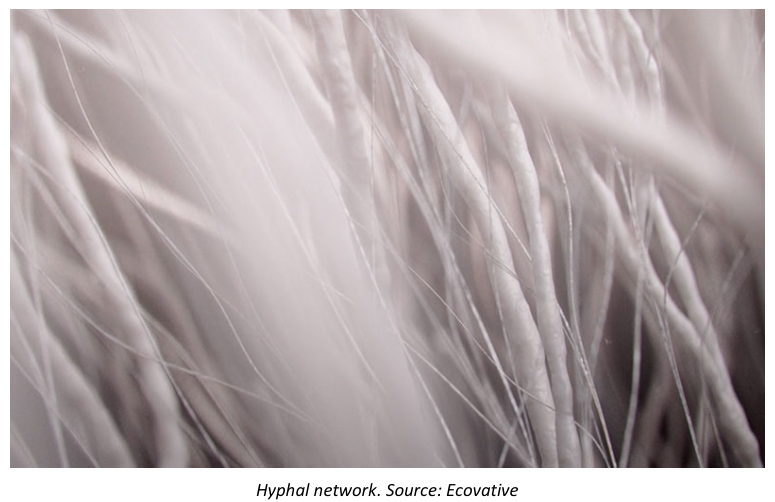
菌糸のネットワークは、菌類をベースとした構造物の基盤であり、構造的完全性と材料適応性をもたらす。
菌糸体は驚異的な回復力と適応力を持っている。森林や草原から砂漠や極地に至るまで、多様な環境で成長することができる。菌糸体は地球上で最も大きな生命体のひとつと考えられており、ひとつの菌糸体が数エーカーもの広大な地域に広がることもある。さらに、菌糸体は成長し、環境に適応するユニークな能力を持っている。温度、湿度、その他の条件の変化に対応することができ、構造的な損傷を自己修復できる可能性がある。この適応性は、生きた、応答性のある建築システムを創造するための興味深い可能性を提供する。
建築を目的とした真菌類にはいくつかの種類があり、それぞれが異なる特性を持っている。Pleurotus属やGanoderma属のような菌糸体を形成する真菌は、その急速な成長と様々な基質と結合する能力により、一般的に使用されている。霊芝菌糸体は強力な菌糸成長を示し、基質の迅速な形成とコロニー形成を可能にする。また、優れた結合能力を持ち、生育培地として使用される農業廃棄物や基質を効果的に結合する。Trametes versicolorと同様に、リグニン分解菌はリグニンを多く含む物質を分解することができ、バイオレメディエーションや建設用途に適している。Neurospora crassaやAspergillus nigerを含む糸状菌は、複雑でカスタマイズ可能な構造を作る可能性があるとして研究されている。
真菌ベースの構造物の製造にはいくつかの段階がある。まず、真菌の増殖に必要な栄養素を供給する適切な基質を設計し、準備することから始まる。基質には、わらや木材チップなどの農業廃棄物から合成素材までさまざまなものがある。基質に真菌の胞子や菌糸を植え付けたら、温度や湿度など最適な生育条件を維持し、菌糸の拡大を促進する。成形や3Dプリンティングのような成形・形成技術は、所望の構造を達成するために採用することができる。後処理工程には、材料の特性を高めるための乾燥、熱処理、表面改質などが含まれる。出来上がった材料は軽量で強度があり、生分解性であるため、コンクリートやプラスチック、発泡スチロールのような従来の建築材料に代わる環境に優しい材料となる。
真菌ベースの材料は、興味深い構造特性を示す。それらは優れた強度対重量比を提供する、固有の軽量繊維状構造を持っている。菌糸のネットワークは絡み合い、高い耐荷重性を持つインターロッキング構造を作り出す。また、これらの素材は優れた断熱性を示し、建物の外壁に適している。相互接続された菌糸はエアポケットのネットワークを作り出し、温度調節とエネルギー消費の削減に役立つ。また、菌糸体断熱材は耐火性でもあり、音波を吸収・発散させ、建築音響を改善することができる。さらに、その自然な寸法安定性と吸湿能力は、耐久性と多様な建築用途への適合性に貢献している。型枠や型枠の中で菌糸を成長させることで、強度と耐久性が試験された強固な構造体を形成することができる。これらの構造体は、壁、パネル、梁、その他の建築要素に使用することができる。
真菌を利用した建築物を含む生きた材料の最も大きな利点のひとつは、その環境持続性である。真菌の増殖は、農業副産物のような有機廃棄物を燃料とするため、再生不可能な資源や資源集約的な製造工程への依存を減らすことができる。さらに、生産工程は最小限の炭素排出を生み出し、カーボンフットプリントの削減に貢献する。真菌素材は生分解性でもあり、循環型経済のコンセプトをサポートし、廃棄物の発生を最小限に抑える。生きた素材を使用することで、エコロジカルなデザインを促進し、都市環境における生物多様性を促進することもできる。さらに、ミセリウムは成長する過程で大気中の炭素を積極的に隔離する。
再生建材を作るために菌糸体と食品廃棄物に投資し、それを推進している企業の例を3つ紹介しよう:
1. バイオーム
Biohmはロンドンを拠点とする企業で、バイオベースの素材と持続可能な建設の分野における革新的なソリューションの研究、開発、導入に注力している。自然や生物学の原理を取り入れ、より健康的で環境に優しい空間を創造することで、建築環境を変革することを目指している。バイオエムの主な目的は人間と環境の幸福を優先した持続可能な建築材料とシステムを開発することである。効率的で持続可能なソリューションを開発するために、自然から着想を得た設計手法であるバイオミミクリーの可能性を追求している。
バイオエムの主要製品のひとつにトライアゴミーというものがある。これはバイオベースの断熱材で、わら、麻、トウモロコシの茎などの農業廃棄物を天然バインダーと混合して利用する。トリアゴミーは、優れた断熱性能、調湿性、音響特性を備えており、従来の断熱材に代わる理想的な環境負荷の少ない断熱材である。同社によると、「トライアゴミーと従来の工法を比較したライフサイクル評価では、エココンクリートのような従来の材料を使用した場合、環境負荷が40%から90%削減されることが示されています。さらに評価を進めると、当社のバイオ由来材料を取り入れることで、トライアゴミーは最大120%の環境負荷削減を達成できることがわかりました。”
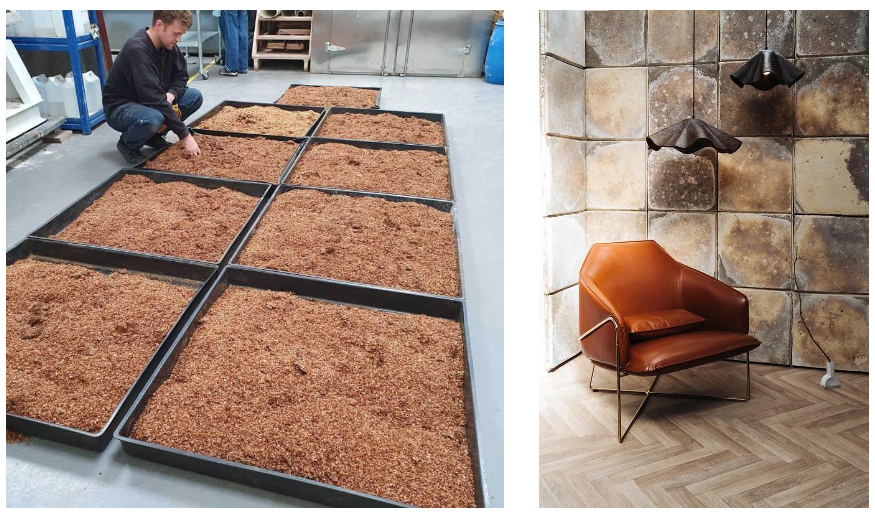 </img
</img
左の画像: Biohmはオレンジの皮、カカオの殻、その他の食品廃棄物を使い、菌糸体ベースの断熱パネル、植物ベースのコンクリート代替品、木材ベースの建築用シートの持続可能な代替品などの建築資材を開発・設計している。右画像:菌糸体ベースの壁パネル。出典 バイオーム
Biohmはまた、循環経済の原則を支える革新的な建設システムの開発にも力を入れている。モジュール建築技術を採用し、解体して材料を再利用する建物を設計することで、廃棄物の発生を減らすことを目指している。Biohmは、農業廃棄物でキノコを栽培し、菌糸(菌をつなぐ糸のような根)を使って、クリーンで効果的な断熱パネルや壁パネルを作る(右の画像)。バイオベースの材料の使用を重視することで、再生不可能な資源への依存を最小限に抑え、建設産業に関連する二酸化炭素排出量を削減するよう努めている。
バイオエムは材料開発だけでなく、建設プロジェクトに持続可能な手法を取り入れるためのコンサルタントおよび設計サービスも提供している。建築生物学、循環型デザイン、バイオベースの材料選択などの分野で専門知識を提供している。コンサルティング・サービスを通じて、Biohmは業界全体の意識を高め、持続可能な建設手法の採用を促進することを目指している。Biohmの持続可能性へのアプローチは、材料や建設技術にとどまらない。室内空気の質、バイオフィリア(建築環境に自然の要素を取り入れること)、建築物が人の健康に与える潜在的な影響などを考慮し、居住者の健康と幸福を優先している。環境フットプリントを最小限に抑えながら、居住者の全体的な生活の質を高める空間づくりに努めている。
2.モグ</strong
イタリアのイナルツォに位置するモグは、菌糸体(菌類の植物体)を利用した持続可能な素材の開発と生産を専門とする企業である。同社は、様々な産業向けに革新的で環境に優しいソリューションを生み出すために、菌類をベースとした素材を活用する最前線にいる。モグ社は、菌糸体を利用した建築・インテリア分野向けの製品に主眼を置いており、環境に優しいだけでなく、建築用途に適した優れた特性を持つ様々な素材を開発している。

モグの製品ラインナップには、音響パネル、壁材、家具、床材、パッケージング・ソリューションなど、菌糸をベースにした様々な用途がある。これらの素材は、色、質感、形状をカスタマイズすることができ、さまざまなデザインニーズに対応できる汎用性を備えている。同社は、建築家、デザイナー、メーカーと協力し、同社の素材を実際のプロジェクトに取り入れることで、従来の素材ではエコロジカル・フットプリントが大きくなる業界で持続可能な実践を促進することを目指している。同社の主な製品には、以下のようなものがある:
アコースティック・パネル – オフィス、学校、公共施設など様々な空間における吸音性を高め、騒音を低減するよう設計されている。これらのパネルは機能的で美観に優れ、従来の吸音材に代わる持続可能な選択肢を提供します。
壁材 – モグの菌糸を使用した壁材は、環境に優しいインテリアの選択肢を提供します。持続可能性を促進しながら、ユニークな質感と視覚的な魅力を提供します。
家具とフローリング – 菌糸をベースにした素材を使ってデザイン・製造されています。これには、椅子、テーブル、フレックスカバー、タイルなどが含まれ、そのバイオマテリアルの多様性と強度を示している。これらの家具や床材は環境にやさしく、見た目も美しく、耐久性に優れている。
菌糸体ベースの素材を使用したパッケージング・ソリューション-これらの素材は様々な形や大きさに成形することができ、プラスチックや発泡スチロールのような従来のパッケージング素材に関連する環境への影響を軽減し、保護的で堆肥化可能なパッケージを作ることができる。
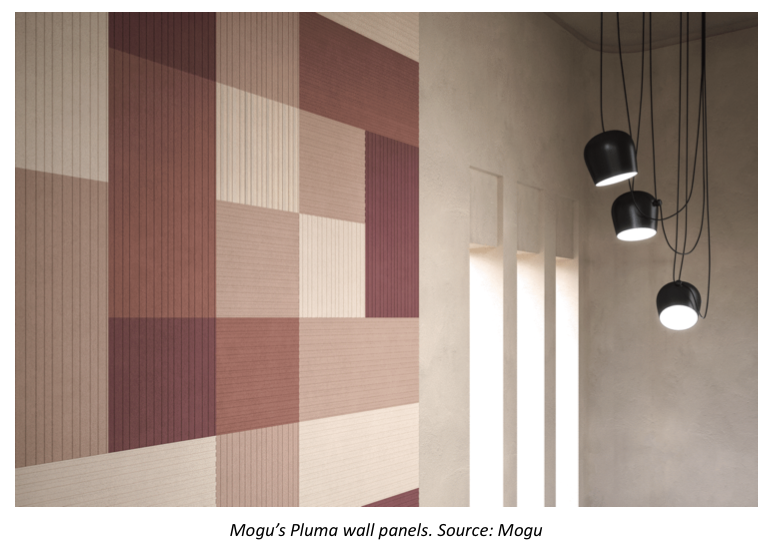 モグのサステナビリティへの取り組みは、食品だけでなく、飲料、化粧品、食品添加物など、さまざまな分野で活用されています。
モグのサステナビリティへの取り組みは、食品だけでなく、飲料、化粧品、食品添加物など、さまざまな分野で活用されています。
モグの持続可能性への取り組みは、製品だけにとどまらない。地元産の農業廃棄物を原料として使用し、クローズドループの生産プロセスを導入することで、環境への影響を最小限に抑える努力をしている。循環型経済の原則を優先し、ライフサイクルの終わりにリサイクルまたは堆肥化できる完全な生分解性素材を作ることを目指しています。革新的なアプローチと持続可能な素材への献身を通じて、モグは真菌を利用した建築分野の発展に重要な役割を果たしている。同社の製品は、再生不可能な資源への依存を減らし、より持続可能で再生可能な建築と設計のアプローチを促進する、従来の材料に代わる実行可能な選択肢を提供します。
3.エコベーティブ</strong
Ecovativeはニューヨークを拠点とする企業で、菌糸体バイオファブリケーションと呼ばれるユニークなアプローチを用いた持続可能な素材の開発と生産を専門としている。同社は、建設、包装、ファッション、食品など様々な産業において、従来の素材に代わる環境に優しい素材を生み出すために、菌類をベースとした技術を活用する最前線にいる。
エコバティブの主要製品のひとつにマイココンポジットというものがある。これは、農業廃棄物、特に麻に菌糸を繁殖させることによって作られる、多用途、生分解性、高性能の素材である。菌糸は天然のバインダーとして機能し、様々な形や大きさに成形できる丈夫で耐久性のある複合材を形成する。MycoCompositeは、プラスチック発泡体、包装材料、建築の構造部品の代替となる。エコバティブはまた、Foragerフォームも提供している。柔軟性のあるバイオベースのフォーム材で、履物、椅子張り、包装用途に使用できる。Foragerは石油ベースのフォームに代わる持続可能な代替品を提供し、優れたクッション性と衝撃吸収性を提供します。
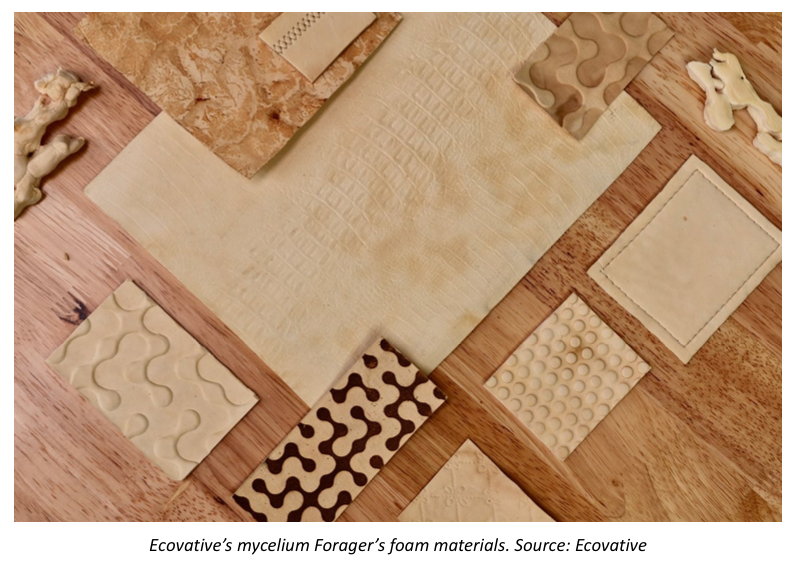 エコベーティブは循環型経済を推進しています。
エコベーティブは循環型経済を推進しています。
エコバティブは、ライフサイクルの終わりに堆肥化できる素材を設計し、ループを閉じて廃棄物を最小限に抑えることで、循環型経済を推進している。再生可能エネルギーを利用し、水の使用量を最小限に抑えるなど、環境に配慮した製造方法を優先している。さらに、エコバティブはパッケージング、消費財、建設など様々な業界と積極的に協力し、菌類をベースとした素材を既存のサプライチェーンや用途に組み込んでいる。カスタマイズとコンサルティングサービスを提供し、企業が持続可能な素材を製品に取り入れる手助けをしている。
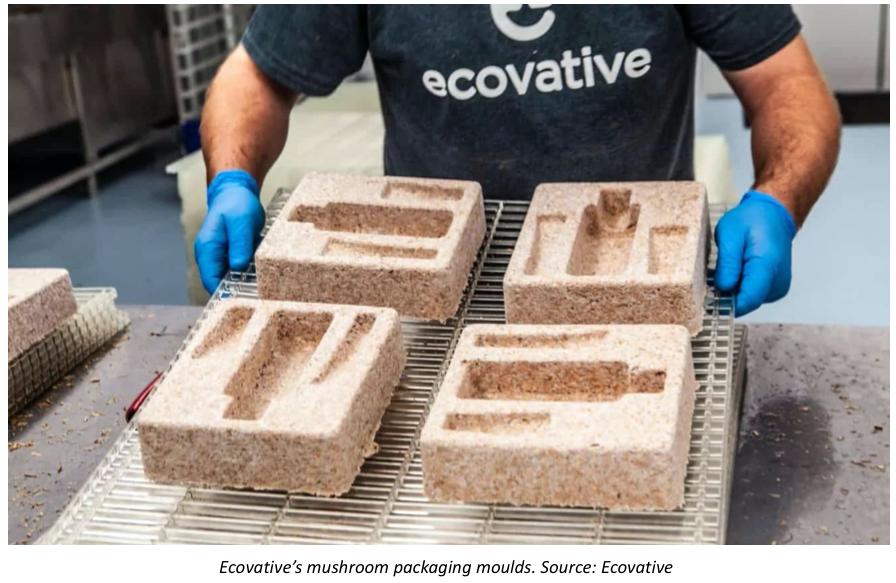 </img
</img
生きた素材、特に菌類を使った建築は、持続可能で適応性のある建築への有望な道を提供する。菌類を使った建築の最先端技術は、その成長能力や自己組織化能力から、構造的完全性や環境的利点に至るまで、その驚くべき特性を浮き彫りにしています。課題は残るものの、継続的な研究、学際的なコラボレーション、革新的な技術により、生きた素材を建築の主流に取り入れる道が開かれるだろう。私たちがより持続可能な未来への道を歩むとき、これらの生きた素材は、私たちの建築方法を再構築し、建築と自然界のより調和的な関係に貢献する可能性を秘めている。
インパクト・ステートメント</strong
菌糸体をベースとした建築・建設はまだ新しい分野であり、建設分野への影響も徐々に大きくなっている。注目され、有望視されている一方で、菌糸体ベースの建築はまだ広く採用されたり、大規模に実施されたりしていないことに注意することが重要である。とはいえ、従来の建材に代わる持続可能で低炭素、かつ汎用性の高い代替手段を提供することで、建設部門を混乱させる可能性はある。継続的な研究、投資、採用は、その影響を加速させ、将来的に建設・建築の現実的で主流な選択肢とするのに役立つだろう。
以下は、菌糸体や菌類を利用した材料を大規模に建築に利用することで、どのような影響がもたらされる可能性があるのか、その一例である:
・持続可能性: 持続可能性:菌糸体は農業廃棄物や副産物を利用して栽培できるため、持続可能な素材であり、セメントや鋼鉄のような従来の建設資材の必要性を減らすのに役立つ。また、二酸化炭素排出量も少なく、全体的な環境への影響も軽減できる。
・生分解性: 菌糸体をベースとした材料は生分解性があり、時間の経過とともに自然に分解される。この特性により、建設廃棄物や埋立地の負担を軽減することができる。
・断熱性と耐火性 断熱性・耐火性:菌糸体は断熱性に優れ、耐火性にも優れているため、様々な建築用途に適している。
・軽量: 軽量:菌糸体ベースの材料は軽量であるため、輸送が簡素化され、 建設時のエネルギー消費を抑えることができる。
・汎用性: 多様性:菌糸体はさまざまな形状に成形できるため、建築用部材や建築用パネルなど、建築における多様な用途に使用できる。
・強度と耐久性: 強度と耐久性:菌糸体をベースにした材料の中には、驚異的な強度と耐久性を示すものがあり、建築の耐荷重要素に適している。
・バイオミミクリーの可能性 バイオミミクリー(生物模倣)の可能性:菌糸体を建築に利用することで、バイオミミクリー(生物模倣)の原理を探求することができ、より効率的で持続可能な建物を作るために自然のデザインを活用することができる。
・空気の質の改善: 菌糸体には有機物を分解する能力があり、有害物質を除去することで室内の空気の質を改善できる可能性がある。
・コスト削減の可能性: コスト削減の可能性:さらなる研究開発が必要であるが、菌糸体ベースの材料は、従来の建材とコスト競争力を持ち、長期的にはコスト削減につながる可能性がある。
・循環型経済の促進: 循環型経済の推進:菌糸体や菌類をベースとした材料を建築に取り入れることは、廃棄物の流れや再生可能な資源を再生的に利用することで、循環型経済の原則に合致する。
菌類を利用した建設ソリューションは、国連の持続可能な開発目標(Sustainable Development Goals)を実現する大きなチャンスとなる:
#9 回復力のあるインフラを構築し、包括的で持続可能な産業化を促進し、生物学的で適応力があり回復力のある材料を用いた建設におけるイノベーションを促進する;
#11 激しい気象現象や建設廃棄物による地域災害リスクを軽減することで、都市と居住地を包括的で安全、弾力的かつ持続可能なものにする;
#12 エネルギー消費量が少なく、生分解性、弾力性、再生可能性に優れた生物素材を使用することで、持続可能な消費・生産パターンを確保する;
#13 再生不可能でエネルギーを消費する資源を生物学的資源で代替することにより、気候変動とその影響と闘うための緊急行動をとる。
システムの視点</strong
科学的研究によれば、菌糸体を利用した建設や建築は、実現可能で費用対効果が高く、持続可能な可能性を秘めている。しかし、菌糸体ベースの建築は有望ではあるものの、まだ開発・採用の初期段階であることに注意することが重要である。製造工程を改良し、材料特性を最適化し、構造的安定性を確保し、規制基準を満たすためには、さらなる研究と技術革新が必要である。とはいえ、菌糸体ベースの建築の潜在的な利点から、持続可能な建築とデザインにとって、この分野はエキサイティングな探求分野である。
特に、菌糸体ベースの建築は、コンクリートや鉄のような伝統的な建築材料に比べて安価になる可能性がある。その理由は多岐にわたるが、菌糸体は藁やおがくず、木材チップといった低コストあるいは農業廃棄物や副産物を使って栽培できるため、セメントや鋼鉄のような材料の抽出や加工に比べ、容易に入手可能で安価であるという事実がある。また、菌糸体の培養や加工に必要なエネルギーは、従来の建築資材の生産に比べ、一般的に少なくて済む。菌糸体ベースの材料の成長プロセスは比較的ローテクで、高温の窯やエネルギー集約的な製造工程を必要としない。これはコスト削減に貢献する。建設技術に関しても、菌糸体ベースの素材は成形することができるため、複雑な建設技術を必要としない。これにより、人件費と工期を削減できる可能性がある。最後に、これらの材料は多くの場合、現場や建設現場の近くで栽培することができるため、重い従来の建築材料を長距離移動させることに伴う輸送コストを最小限に抑えることができる。
さらに、藁や土など、持続可能な建築に一般的に使用される他の天然素材と比較した場合、菌糸体ベースの建築は、資源の利用、体積エネルギーの低減(体積エネルギーとは、素材の抽出、加工、製造、輸送に必要な総エネルギーを指す)、環境への影響の低減(菌糸体の成長には二酸化炭素の隔離が含まれるため、潜在的にカーボン・ネガティブな素材となり、温室効果ガスの排出を削減することで気候変動の緩和に貢献する可能性がある)など、持続可能性に関するいくつかの利点がある。
しかし、菌糸体を使った建築の費用対効果はまだ調査中であり、その商業的な実行可能性はさらなる研究、開発、生産規模に左右されることに留意する必要がある。コストは、特定の製剤、生産規模、原材料の地域的入手可能性、現地の人件費などの要因によって変動する可能性がある。一方、さまざまな建設資材の持続可能性は、現地での入手可能性、特定のプロジェクト要件、使用される状況などの要因に左右される可能性がある。持続可能性という観点からは、各材料にはそれぞれ独自の利点や考慮すべき点があり、特定の材料が適しているかどうかは、具体的なプロジェクトの目標や制約に左右される。
真菌を利用した建築は大きな可能性を秘めているが、その普及のためにはいくつかの課題に対処しなければならない。一貫した品質と構造的信頼性を確保しながら、建設需要を満たすために生産工程を拡大することは、依然として重要な課題である。安全性とコンプライアンスを確保するために、標準化と規制の枠組みを開発する必要がある。真菌ベースの材料をデジタル加工技術と統合することで、設計の柔軟性と精度を高めることができる。さらに、バイオファブリケーションとリビングアーキテクチャーの概念を探求することで、将来の建設実践のためのエキサイティングな可能性が開かれる。
リンクと連絡先</strong
リンク
モグのウェブサイト https://mogu.bio/
エコバティブのウェブサイト: https://www.ecovative.com/
Biohmのウェブサイト: https://www.biohm.co.uk/
参考文献
Vallas, T., & Courard, L. (2017). 建築における自然の利用: 菌糸と樹木を使った生きた家の建築。Frontiers of Architectural Research, 6(3), 318-328.
https://doi.org/10.1016/j.foar.2017.05.003
https://www.sciencedirect.com/science/article/pii/S2095263517300353
***
人類は、地球上の生命が繁栄し続けるために克服しなければならない4つの必須生存課題(4Revs)、すなわちボトルネックに直面しています: 食料、水、資源、気候変動・エネルギーです(詳細は下記)。この4つの領域は、革命的なイノベーションを必要とすると同時に、新しい機会の宝庫でもあります。
4Revsは、人類がこの4つの分野を解決するためのユニークな共創型エコシステムです。
4Revsは、2020年から2050年にかけての一世代で、人類がこれら4つの生存課題を解決することを目指す、ユニークな共創エコシステムです。
***
※原文(英語)を自動翻訳したものです。詳細に関しては事務局までお問い合わせください。
お問い合わせはこちらから
https://4revs.net/contact/
Nov 15, 2023
Alternatives in Construction: Mycelium-based Technology
#nature-base-solution#bio-based-materials#sustainable-architecture#greenhouse-gases#urban-city-design
Abstract
Living materials, which leverage the inherent properties and self-organizing capabilities of living organisms, have gained substantial interest in the construction field due to their unique combination of sustainability, biocompatibility, and adaptability.
Among the various living materials, fungi-based constructions have emerged as a promising avenue, harnessing the remarkable attributes of fungi to create resilient, environmentally friendly, and innovative architectural solutions.
This case provides an overview of the state-of-the-art in fungal-based constructions and explores the key principles underlying such constructions, the types of fungi used, and the structural properties and performance characteristics of resulting fungal materials. Additionally, it discusses the environmental benefits, limitations, and future prospects of fungal-based constructions, paving the way for integrating living materials into mainstream construction practices. The case also highlights three companies– Biohm, Mogu, and Ecovative– that are at the forefront of fungal-based construction.

Main Highlights
Problem: The construction sector has a significant environmental impact globally, ranging from greenhouse gasses emissions, resource depletion, waste generation, habitat destruction and land use, air and water pollution, energy consumption and indirect impact on climate change by building infrastructure and buildings that may not be energy-efficient or resilient to climate change impacts, thereby increasing the need for cooling, heating, and artificial lighting.
Context: There are several solutions for the construction sector, ranging from the circular use of resources to alternative materials, especially those of natural origin.
Solution: Constructions from living materials, particularly fungi, offer a promising path towards sustainable and adaptive architecture. Mycelium is incredibly resilient and adaptable. It also possesses excellent binding capabilities and inherent lightweight, fibrous structures that offer excellent strength-to-weight ratios.
Impact Statement: Mycelium-based construction and architecture are still emerging fields. Nevertheless, it can potentially disrupt the construction sector by offering sustainable, low-carbon, and versatile alternatives to traditional building materials.
Systems Perspective: Scientific research suggests that mycelium-based construction and architecture have the potential to be feasible, cost-effective, and sustainable. However, it’s important to note that the cost-effectiveness of mycelium-based construction is still being explored, and its commercial viability is subject to further research, development, and scale of production. While fungal-based constructions hold tremendous potential, several challenges must be addressed for their widespread adoption.
Case Overview
In recent years, the construction field has witnessed a remarkable shift towards sustainable and environmentally friendly practices. Among the emerging approaches, using living materials has garnered significant attention due to its potential to revolutionize the way we build. Living materials leverage living organisms’ inherent properties and abilities to create resilient, adaptive, and biocompatible structures. Fungi-based constructions offer unique advantages such as sustainability, versatility, and regenerative potential, making them an intriguing avenue for innovative architectural solutions.
Fungi are a diverse kingdom of organisms that possess extraordinary capabilities. They have the ability to grow and self-assemble, forming complex networks of filaments called mycelium. Mycelium is the vegetative part of a fungus, and it consists of a network of fine, thread-like structures called hyphae. These hyphae grow underground or within a substrate, forming a vast network called a mycelial network. The mycelial network is the foundation for fungal-based constructions, imparting structural integrity and material adaptability.

Mycelium is incredibly resilient and adaptable. It can thrive in diverse environments, ranging from forests and grasslands to deserts and even polar regions. It is considered one of the largest living organisms on Earth: a single fungal organism can spread over vast areas, often covering several acres. Moreover, mycelium possesses the unique ability to grow and adapt to its environment: it can respond to changes in temperature, humidity, and other conditions, allowing it to potentially self-repair structural damage. This adaptive quality offers intriguing possibilities for creating living, responsive architectural systems.
Several types of fungi have been explored for construction purposes, each with its distinct attributes. Mycelium-forming fungi, such as species from the genus Pleurotus and Ganoderma, are commonly used due to their rapid growth and ability to bind with various substrates. Ganoderma mycelium exhibits strong mycelial growth, which allows for rapid formation and colonization of the substrate. It also possesses excellent binding capabilities, effectively binding together the agricultural waste or substrate used as the growth medium. Akin to Trametes versicolor, lignin-degrading fungi can decompose lignin-rich materials, making them suitable for bioremediation and construction applications. Filamentous fungi, including Neurospora crassa and Aspergillus niger, are being investigated for their potential to create intricate and customizable structures.
The production of fungal-based constructions involves several stages. It starts with designing and preparing a suitable substrate that provides the necessary nutrients for fungal growth. The substrate can range from agricultural waste, such as straw and wood chips, to synthetic materials. Once the substrate is inoculated with fungal spores or mycelium, optimal growth conditions, including temperature and humidity, are maintained to promote mycelial expansion. Shaping and forming techniques, such as molding or 3D printing, can be employed to achieve desired structures. Post-processing steps may include drying, heat treatment, or surface modifications to enhance the material’s properties. The resulting material is lightweight, strong, and biodegradable, making it an eco-friendly alternative to traditional construction materials like concrete, plastic, or foam.
Fungal-based materials exhibit intriguing structural properties. They possess inherent lightweight, fibrous structures that offer excellent strength-to-weight ratios. The mycelial networks intertwine, creating interlocking structures with high load-bearing capacity. These materials also exhibit good thermal insulation properties, making them suitable for building envelopes. The interconnected hyphae create a network of air pockets, which helps regulate temperature and reduce energy consumption. Mycelium insulation is also fire-resistant and can absorb and dissipate sound waves, improving building acoustics. Furthermore, their natural dimensional stability and moisture absorption capabilities contribute to their durability and suitability for diverse construction applications. By growing mycelium within molds or formwork, it can form solid structures that have been tested for strength and durability. These structures can be used for walls, panels, beams, and other architectural elements.
One of the most significant advantages of living materials, including fungal-based constructions, is their environmental sustainability. Fungal growth is fueled by organic waste materials such as agricultural byproducts, reducing the reliance on non-renewable resources or resource-intensive manufacturing processes. Moreover, the production process generates minimal carbon emissions, contributing to a reduced carbon footprint. Fungal materials are also biodegradable, supporting the concept of a circular economy and minimizing waste generation. Using living materials can also foster ecological design and promote biodiversity in urban environments. Additionally, mycelium actively sequesters carbon from the atmosphere during its growth.
Here are three examples of companies investing in and promoting mycelium and food waste to create regenerative construction materials:
1. Biohm
Biohm is a London-based company that focuses on research, development, and implementation of innovative solutions in the field of bio-based materials and sustainable construction. They aim to transform the built environment by incorporating principles from nature and biology to create healthier, more environmentally friendly spaces. Biohm’s primary objective is to develop sustainable building materials and systems prioritizing human and environmental well-being. They explore the potential of biomimicry, a design approach inspired by nature, to develop efficient and sustainable solutions.
One of Biohm’s key products is called Triagomy. It is a bio-based insulation material that utilizes agricultural waste, such as straw, hemp, or corn stalks, mixed with a natural binder. Triagomy offers excellent thermal performance, moisture regulation, and acoustic properties, making it an ideal alternative to traditional insulation materials with a lower environmental impact. According to the company, “Life-cycle assessments comparing Triagomy with traditional construction methods have shown 40% to 90% reductions in the environmental impact, using conventional materials such as eco-concrete. Further assessments show that by incorporating our bio-based materials, Triagomy is able to achieve reductions of up to 120% in the environmental impact.”

Left Image: Biohm uses orange peel, cocoa husks, and other food waste, to develop and design construction materials such as mycelium-based insulation panels, plant-based concrete alternatives, and sustainable replacers for wood-based construction sheets. Right Image: mycelium-based wall panels. Source: Biohm
Biohm also focuses on developing innovative construction systems that support circular economy principles. They aim to reduce waste generation by employing modular construction techniques and designing buildings for disassembly and material reuse. Biohm grows mushrooms in agricultural waste, and then uses mycelium, the thread-like roots that connect the fungus, to make clean, effective insulation panels or wall panels (image to the right). By emphasizing the use of bio-based materials, they strive to minimize the reliance on non-renewable resources and reduce carbon emissions associated with the construction industry.
In addition to material development, Biohm offers consultancy and design services to help clients integrate sustainable practices into their construction projects. They provide expertise in areas such as building biology, circular design, and bio-based materials selection. Through their consulting services, Biohm aims to raise awareness and promote adopting sustainable construction practices across the industry. Biohm’s approach to sustainability extends beyond materials and construction techniques. They prioritize the health and well-being of occupants by considering indoor air quality, biophilia (integrating natural elements into built environments), and the potential impact of buildings on human health. They strive to create spaces that enhance the overall quality of life for occupants while minimizing the environmental footprint.
2. Mogu
Located in Inarzo in Italy, Mogu is a company that specializes in the development and production of sustainable materials using mycelium, the vegetative part of fungi. They are at the forefront of utilizing fungal-based materials to create innovative, eco-friendly solutions for various industries. Mogu’s primary focus is on mycelium-based products for the construction and interior design sectors: they have developed a range of materials that are not only environmentally friendly but also possess exceptional properties suitable for construction applications.

Mogu’s product range includes various applications of mycelium-based materials, such as acoustic panels, wall coverings, furniture, floors and packaging solutions. These materials can be customized in terms of color, texture, and shape, providing versatility for different design needs. The company collaborates with architects, designers, and manufacturers to incorporate their materials into real-world projects, aiming to promote sustainable practices in industries where traditional materials have a larger ecological footprint. Some of their key products include:
Acoustic Panels – designed to improve sound absorption and reduce noise in various spaces such as offices, schools, and public buildings. These panels are functional and aesthetically pleasing, offering a sustainable alternative to conventional acoustic materials.
Wall Coverings – Mogu’s mycelium-based wall coverings provide an eco-friendly option for interior design. These coverings can be used in both residential and commercial spaces, offering a unique texture and visual appeal while promoting sustainability.
Furniture and Flooring – designed and manufactured using mycelium-based materials. This includes chairs, tables, Flex covering and tiles and other pieces that showcase the versatility and strength of their biomaterials. These furniture and floor items are environmentally friendly, visually appealing, and durable.
Packaging Solutions using mycelium-based materials- these materials can be molded into various shapes and sizes to create protective and compostable packaging, reducing the environmental impact associated with traditional packaging materials like plastics or foams.

Mogu’s commitment to sustainability extends beyond its products. They strive to minimize their environmental impact by using locally sourced agricultural waste as feedstock and implementing a closed-loop production process. They prioritize the principles of the circular economy, aiming to create fully biodegradable materials that can be recycled or composted at the end of their lifecycle. Through their innovative approach and dedication to sustainable materials, Mogu is playing a significant role in advancing the field of fungal-based constructions. Their products offer viable alternatives to traditional materials, reducing reliance on non-renewable resources and promoting a more sustainable and regenerative approach to building and design.
3. Ecovative
Ecovative is a New York based company that specializes in developing and producing sustainable materials using a unique approach called mycelium biofabrication. They are at the forefront of utilizing fungal-based technologies to create environmentally friendly alternatives to conventional materials across various industries: construction, packaging, fashion and food.
One of Ecovative’s primary products is called MycoComposite. It is a versatile, biodegradable, and high-performing material made by growing mycelium on agricultural waste, especially hemp. The mycelium acts as a natural binder, forming a strong and durable composite that can be molded into various shapes and sizes. MycoComposite can be an alternative to plastic foams, packaging materials, and structural components in construction. Ecovative also offers Forager foam, a flexible and bio-based foam material that can be used in footwear, upholstery, and packaging applications. Forager provides a sustainable alternative to petroleum-based foams, offering excellent cushioning and shock-absorbing properties.

Ecovative promotes a circular economy by designing materials that can be composted at the end of their life cycle, closing the loop and minimizing waste. They prioritize environmentally friendly manufacturing practices, utilizing renewable energy sources and minimizing water usage. Furthermore, Ecovative actively collaborates with various industries, including packaging, consumer goods, and construction, to integrate their fungal-based materials into existing supply chains and applications. They offer customization and consulting services to help companies incorporate sustainable materials into their products.

Constructions from living materials, particularly fungi, offer a promising path towards sustainable and adaptive architecture. The state of the art in fungal-based constructions highlights their remarkable properties, ranging from their growth and self-assembly capabilities to their structural integrity and environmental benefits. While challenges remain, continued research, interdisciplinary collaboration, and innovation will pave the way for integrating living materials into mainstream construction practices. As we navigate the path towards a more sustainable future, these living materials have the potential to reshape the way we build and contribute to a more harmonious relationship between architecture and the natural world.
Impact Statement
Mycelium-based construction and architecture are still emerging fields and their impact on the construction sector is slowly growing. While it is gaining attention and showing promise, it’s important to note that mycelium-based construction is not yet widely adopted or implemented at a large scale. Nevertheless, it can potentially disrupt the construction sector by offering sustainable, low-carbon, and versatile alternatives to traditional building materials. Continued research, investment, and adoption can help accelerate its impact and make it a viable and mainstream option for construction and architecture in the future.
Here are some of the several potential impacts of using mycelium and fungal-based materials in construction on a large scale:
● Sustainability: Mycelium is a sustainable material as it can be grown using agricultural waste or by-products, which helps reduce the need for traditional construction materials like cement and steel. It has a lower carbon footprint and reduces overall environmental impact.
● Biodegradability: Mycelium-based materials are biodegradable, meaning they can break down naturally over time. This characteristic can reduce the burden of construction waste and landfill usage.
● Insulation and Fire Resistance: Mycelium materials have good insulation properties and can offer fire resistance, making them suitable for various construction applications.
● Lightweight: Mycelium-based materials are lightweight, which can simplify transportation and decrease energy consumption during construction.
● Versatility: Mycelium can be molded into various shapes and forms, allowing for versatile applications in construction, including architectural components and building panels.
● Strength and Durability: Some mycelium-based materials exhibit impressive strength and durability, making them suitable for load-bearing elements in construction.
● Biomimicry Potential: The use of mycelium in construction allows for the exploration of biomimicry principles, leveraging nature’s design to create more efficient and sustainable buildings.
● Air Quality Improvement: Mycelium has the ability to decompose organic matter and can potentially help improve indoor air quality by removing harmful substances.
● Potential Cost Savings: While further research and development are needed, mycelium-based materials can become cost-competitive with traditional construction materials, leading to cost savings in the long run.
● Promotion of Circular Economy: Incorporating mycelium and fungal-based materials into construction practices aligns with circular economy principles by utilizing waste streams and renewable resources regeneratively.
Fungal-based construction solutions present a huge opportunity to help realize the UN Sustainable Development Goals, namely:
#9 Build resilient infrastructure, promote inclusive and sustainable industrialization and foster innovation by fostering innovation in construction using biological, adaptive and resilient materials;
#11 Make cities and human settlements inclusive, safe, resilient and sustainable by reducing the local disaster risks in case of intense meteorological events and construction waste;
#12 Ensure sustainable consumption and production patterns by using biological materials that require less energy, that are biodegradable, resilient and renewable;
#13 Take urgent action to combat climate change and its impacts by substituting non renewable and energy consuming resources with biological ones, by creating building structures resilient and adapt toa changing climate.
Systems Perspective
Scientific research suggests that mycelium-based construction and architecture have the potential to be feasible, cost-effective, and sustainable. However, it’s important to note that while mycelium-based construction shows promise, it is still in the early stages of development and adoption. Further research and innovation are needed to refine the manufacturing processes, optimize material properties, ensure structural stability, and meet regulatory standards. Nevertheless, the potential benefits of mycelium-based construction make it an exciting area of exploration for sustainable architecture and design.
In particular, mycelium-based construction has the potential to be cheaper compared to traditional building materials like concrete or steel, although the exact cost savings can vary depending on several factors. The reasons are multiple, ranging from the fact that mycelium can be grown using low-cost or agricultural waste or byproducts such as straw, sawdust, or wood chips therefore making them readily available and inexpensive compared to the extraction and processing of materials like cement or steel. Also, mycelium cultivation and processing typically require less energy compared to the production of traditional building materials. The growth process of mycelium-based materials can be relatively low-tech and doesn’t involve high-temperature kilns or energy-intensive manufacturing processes. This can contribute to cost savings. Concerning construction techniques, mycelium-based materials can be molded or formed into desired shapes, reducing the need for complex construction techniques. This can potentially lower labor costs and construction time. Finally, these materials can often be grown on-site or near the construction site, minimizing transportation costs associated with moving heavy traditional building materials over long distances.
Moreover, when compared to other natural materials commonly used in sustainable construction, such as straw, earth, and others, mycelium-based construction offers several sustainability advantages, like resource utilization, lower embodied energy (embodied energy refers to the total energy required to extract, process, manufacture, and transport a material), reduced environmental impact (the growth of mycelium involves the sequestration of carbon dioxide, making it a potentially carbon-negative material, that could help mitigate climate change by reducing greenhouse gas emissions).
However, it’s important to note that the cost-effectiveness of mycelium-based construction is still being explored, and its commercial viability is subject to further research, development, and scale of production. The costs can vary based on factors such as the specific formulation, production scale, regional availability of raw materials, and local labor costs. On the other hand, the sustainability of different construction materials can depend on factors such as local availability, specific project requirements, and the context in which they are used. Each material has its own unique advantages and considerations in terms of sustainability, and the suitability of a particular material will depend on the specific project goals and constraints.
While fungal-based constructions hold tremendous potential, several challenges must be addressed for their widespread adoption. Scaling up production processes to meet construction demands while ensuring consistent quality and structural reliability remains a key challenge. Standardization and regulatory frameworks need to be developed to ensure safety and compliance. Integrating fungal-based materials with digital fabrication technologies can enhance design flexibility and precision. Furthermore, exploring the concept of biofabrication and living architectures opens up exciting possibilities for future construction practices.
Links and Contact Information
Links
Mogu website: https://mogu.bio/
Ecovative website: https://www.ecovative.com/
Biohm website: https://www.biohm.co.uk/
References:
Vallas, T., & Courard, L. (2017). Using nature in architecture: Building a living house with mycelium and trees. Frontiers of Architectural Research, 6(3), 318-328.
https://doi.org/10.1016/j.foar.2017.05.003
https://www.sciencedirect.com/science/article/pii/S2095263517300353
最新のピックアップ
-
2024年3月8日
Mar 8, 2024
lithium battery; energy transition; recycling; closed loop

-
2024年3月6日
Mar 6, 2024
Tomato Jos: Investment & Impact into Nigeria’s Tomato Industry

-
2024年3月4日
Mar 4, 2024
ネイチャー・ポジティブに資する 投資は、世界全体のわずか 3%に過ぎない
Only 3 per cent of global investments are nature- positive

-
2024年2月3日
Feb 3, 2024
Towards sustainable regenerative food systems

-
2024年1月4日
Jan 4, 2024
Climate adaptation – 150 options for water in agriculture

